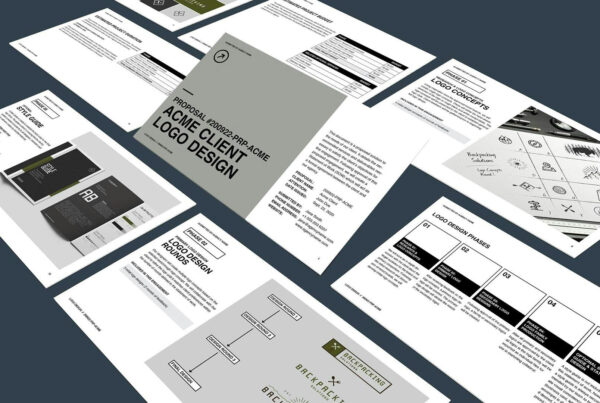The exhilaration of having a ton of cash flowing in and the agony of hearing crickets chirping instead of client phone calls, it is the life of a designer. Countless times in my career I have had moments of panic when the phone stops ringing. “Will it ever ring again?” “Should I apply for that job at McDonalds?” “Does my Mom still have a bed for me at her house?”
What I have learned is that lulls in work can be turned to a calm before the storm if you do the right things. (And, by the way, human nature’s inspiration to have you play Call of Duty all night, watch movies, kill six hours on Facebook, or go to the pool all day is NOT the right thing. Engage in too much of those activities and McDonalds may be your only career option.)

Here are a few ideas to help you turn slow times into future work.
1. Update your portfolio.
“The landscapers lawn is never mowed.” When times are slow it is a great time to design a new portfolio site (or update your current portfolio with recent work). Dedicate yourself to it as if you had a stringent deadline from a client because once the phone starts ringing, paying work always seems to trump polishing up your own portfolio site. While I worked at Fox during the “dot-bomb” my team knew a year and a half in advance that we would eventually be laid off. I must have launched five different portfolio sites as I panicked about my career’s future.
2. Get social.
Take a little time to get active on LinkedIn, Facebook, Twitter, Dribbble, Vimeo, YouTube, Pinterest, or any of the other hot social networks of the hour. Update your profile pictures and other graphics. Make sure you have content in all of the available buckets. Then get active! Start posting some interesting stuff about what you are doing or what you are finding on the web. Your activity is tracked and shoved down the throats of anyone who follows you. This activity will surely help remind customers (old and new) that you exist.
3. Learn something new.
When I first started my design career in the mid-nineties I was working for peanuts at Alphagraphics (and later a few other small, dead-end design shops) in the day and spending my nights teaching myself HTML and Flash. That effort (when I had no freelance work and a low pressure job) made all the difference in my career as I soon found myself creating websites for some of the most recognized brands in the world. Who knows where I would be today if I hadn’t made the effort to learn something new when my career was in its slow early stages. (I certainly wouldn’t be running my own digital agency creating websites for Google, Disney, NBC and the like.)
4. Send “Checking In” emails.
Go through your contact list and send out a few “just checking in” emails. This strategy helps keep you top of mind with old clients and business contacts. It doesn’t have to be anything special or formal, “Hey Cindy, Long time no see! Hope you are doing well. Things have been going great. I just launched a couple new projects ________ & ________. I’d love to work with you again sometime soon. Shoot me a line when you get a chance. I’d love to hear what you have going on. Best, Charlie”
5. De-clutter.
I don’t know about you, but when I’m busy my life gets cluttery. My virtual desktop becomes a mess of random files and screenshots. And my real desktop accumulates piles of paper, sketches, magazines, and Post-It Notes with phone numbers of people I’m supposed to call back. When work requests slow down, take some time to de-clutter. It is a breath of fresh air in the lungs and will help you be ready for the next crashing wave a of client demands.
6. Take someone to lunch.
Is there a client you’d like to land? A partner you owe (programmer, copywriter)? Or maybe an old boss or ex-coworker you’d like to re-connect with? Take a look at your Rolodex and pick a couple people and shoot off a lunch invite, “Hey John! I was thinking about you the other day and thought it’d be fun to reconnect over lunch. You available later this week or next? My treat!”
7. Send some thank you cards or emails.
Everyone loves to receive a little appreciation and recognition and kicking out a “thank you” message to a client, coworker, or boss can go a long way toward building a strong relationship. They don’t need to be overly gushy (unless that is appropriate). Sometimes a simple message like, “Hey John, I was just reviewing some past projects and wanted to thank you for letting me work on ___________ project. It is one of my favorite portfolio pieces. I’m really proud of it and hope it is helping you achieve your marketing goals. On top of the awesome work, it was a pleasure to work with you and your team. You have some super people at your company! Best, Sally” can help put you back on the radar with a potential client or job lead.
8. Archive old projects.
Take a little time to clean off your hard drives and backup storage. If you still have projects on your computer from five years ago, you are likely victimizing yourself with slower than necessary computer performance. Get that junk off your computer. Put everything on a backup drive that you are not currently working on (or that you won’t likely need in the near future). Open up your scratch disk space and let Photoshop stretch her legs for a change.
9. Do a postmortem on a few recent projects.
Pick a handful good, bad, and ugly projects and do an honest assessment of how they went. What went right? What went wrong? What did a I learn to do? What did I learn not to do? How would I rank each project on a scale of 1 to 10?
10. Improve your process.
Your postmortem analysis can help guide you in some process improvement. But also take a look at the often overlooked things like: Design software palette management: Are your palettes in the right places? Can they be moved around to be optimized for faster production speed? Project management software: Is it time to finally sign up for Basecamp? Or switch to something else? Taking the time to do this when times are slow can help you be ready for the future.
11. Polish up your résumé.
If you are a freelance designer, the worst case scenario is that the phone really will never ring again and you will be forced to go find a job. Might as well update your résumé while you have a minute to breathe.
Slow work times happen to the best of us. But being active during them can assure that they don’t last long. The number one objective is for you to create action. Newton’s third law says, “To every action there is always an equal and opposite reaction.” Your actions will create reactions from others that will help generate new work opportunities. Next time you are in between jobs or have a lull in freelance work, give a few of the above suggestions a try.






